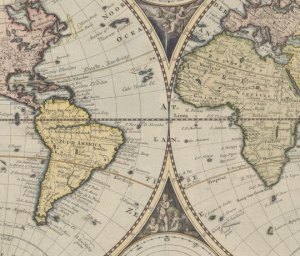Part I: On Mapping Samples
The goal of this project is to visually represent the transmission of sounds—as represented by digital samples—that have been used in the construction of the Black Atlantic through music. Visual representation in the form of mapping takes into account the particular historical, spatial, and cultural forms that were influential in the development and production of music. Historically, most music has borrowed, copied, assimilated, and reproduced rhythms, melodies, and sounds. However, the production of hip-hop has relied on the use of digitized reproductions of existing music. These samples have made the process of identifying the sounds, locating their origin, and tracking how they have been used easier than other musicological investigations of the origins of a particular musical form or genre. But why hip-hop?
In addition to being built literally from older musical forms, hip-hop has evolved into a global lingua franca, a common tongue among young people who often hail from urban, oppressive environments and represent minority populations. Hip-hop has been the voice of multiple generations and has allowed for young people all over the Black Atlantic to tap into the kind of counter-culture of modernity of which Paul Gilroy spoke. Since the late 1990s, hip-hop has also become one of the most profitable genres of music, generating billions of dollars for record companies and distributors who have also contributed their own histories to the process of hip-hop’s evolution. The politics of hip-hop, however, are far more involved than simply a contest between authenticity and “selling out.” Aesthetic choices have had political consequences for MCs, DJs, and producers alike.
Hip-hop’s history as a creation of the South Bronx has long masked the deep connections its earliest practitioners had with the Caribbean and Africa. Hip-hop as a musical genre grew out of Caribbean, African, and African-American sonic, dance, and oral traditions as they were brought together in the South Bronx in the 1960s and 1970s. But from that spot on 168th Street, hip-hop has exploded outward to become a powerful cultural, economic, and social force in the modern world. Representing those traditions and the many directions that they have taken in the intervening forty years remains an important aspect of modern hip-hop culture. Representing these traditions historically and visually, this section illustrates the direct connections between cultures within the African diaspora and the nations that make up the modern world.
Notes On Sources
To accomplish the goal of visual representation, this section relies heavily on the database built and maintained by the user community at WhoSampled? to provide the information about the use and identification of samples. WhoSampled, which as of May 1, 2014 lists 240,721 songs, 85,091Artists, and 144,734 samples contributed by a community of over 10,000 fans does not yet identify samples by their place of origin or track their movement in space.
But what place does music originate? Is it the birthplace of musicians and singers? Is it the place where the record is pressed? Is it the region in which the musical form originated? Is it the sites where it is enjoyed? All of these are valid sites where historians can locate music, but for the purposes of this project this section dodges those ontological question and defaults to the site of recording as the “location” for a given piece of music. While the record studio is distinct from the live stage, the process of recording music is a performance all its own and the studio and its environs can imbue sounds with their own meaning and politics. Record studios also have their own distinct histories, personalities, and sounds. The music that came out of places like Muscle Shoals Sound in Muscle Shoals, Alabama; Lee “Scratch” Perry’s Black Ark Studio in the Washington Gardens neighborhood of Kingston, Jamaica; and The Bomb Squad’s recording studio in Roosevelt, NY have all had important cultural and musical effects that have had impacts far beyond the local reach of that studio’s ability to produce music. Because the studio is also where musicians and producers work together to create a recording it is the site of the creation of a recorded piece of music, though not always the site of origin of that music itself.
The maps that are presented were built using Palladio, a project from the Humanities and Design Lab at Stanford University. One caveat is that the static nature of the maps does not capture the movement of sonic and cultural traditions. The goal of this project and future iterations of it is to offer a way to map these samples which allows for ways to highlight movement, through animation, as well as to convey important information and, ideally, link directly to the samples themselves.
Finally, the work of all of the musicians, producers, DJs, and historians of hip-hop will be represented wherever their work has found its way directly into this project. Each section looks to map a small subset of the WhoSampled database and provides a genealogy of these samples in order to understand why samples are used in particular ways and the reasons behind those choices.
How to cite this page: Romine, David T., “A Sonic Map of the Black Atlantic” Deeps, The Black Atlantic, Duke University, http://sites.duke.edu/blackatlantic/ (accessed on (date)).
